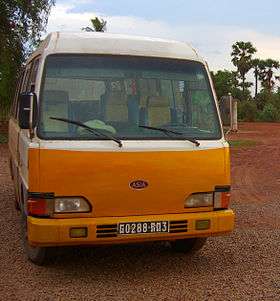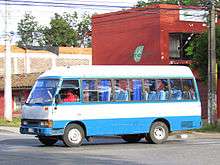Kia Combi
The Kia Combi (originally marketed as the Asia Combi) was a series of mini-buses built from 1983 until October 2002 by Asia Motors, and later Kia Motors.[1] Asia Motors has been owned by Kia since 1976.[2]
| Kia Combi | |
|---|---|
 | |
| Overview | |
| Manufacturer | Asia Motors Kia Motors |
| Also called | Asia Combi Kia Power Combi |
| Production | 1984-2002[1] |
| Body and chassis | |
| Body style | bus |
| Related | Mazda Titan Mazda Parkway |
| Powertrain | |
| Engine | 2,977 cc Mazda HA diesel I4 3,296 cc Hyundai D4AL TD I4 3,749 cc VM 638 OHV diesel I6 3,907 cc Hyundai D4DA TD I4 4,052 cc Mazda ZB diesel I6 |
| Dimensions | |
| Wheelbase | 4,015 mm |
| Length | 6,300 mm |
| Width | 2,000 mm |
| Height | 2,680 mm |
In 1983, the 24-seater Asia Motors AM805/807 "Combi" minibuses were launched, entering full production in 1984. Most versions received the Mazda ZB six-cylinder engine of 4,052 cc. This produced 100 PS (74 kW) at 3,600 rpm. They succeeded the first generation Mazda Parkway, while being based on the second generation Parkway (itself based on the second generation Mazda Titan). In 1988 or 1990 the twin headlights were changed, introducing single, "cats-eye" headlights (AM815). In 1994 the AM815 Hi-Combi was added to the lineup.
For the 1996 model year another modification took place, introducing more modern smaller four-cylinder Hyundai engines with more power as well as a re-designed dashboard. These later models (AM825) also feature twin round headlights. The new inline-four engines included Hyundai's new turbocharged 3.3 L D4AL and 3.9 L D4DA, producing 120 PS (88 kW) and 140 PS (103 kW) respectively.[1][3] Following the 1999 merger of Kia and Hyundai, the Asia sub-brand had vanished by 2000.[2] The vehicle was therefore rebadged as the Kia Power Combi.[1] With stricter South Korean emissions regulations on the horizon for 2003, the Combi was then discontinued without a successor on October 28, 2002.

See also
References
- "Asia Combi". X-bus.ru. Archived from the original on 2013-04-17. Retrieved 2011-07-20.
- World of Cars 2006·2007. Warsaw, Poland: Media Connection Sp. z o.o. 2006. p. 252.
- The Family of Hyundai Engine (PDF), Hyundai Motor Group, p. 2, retrieved 2011-07-20
